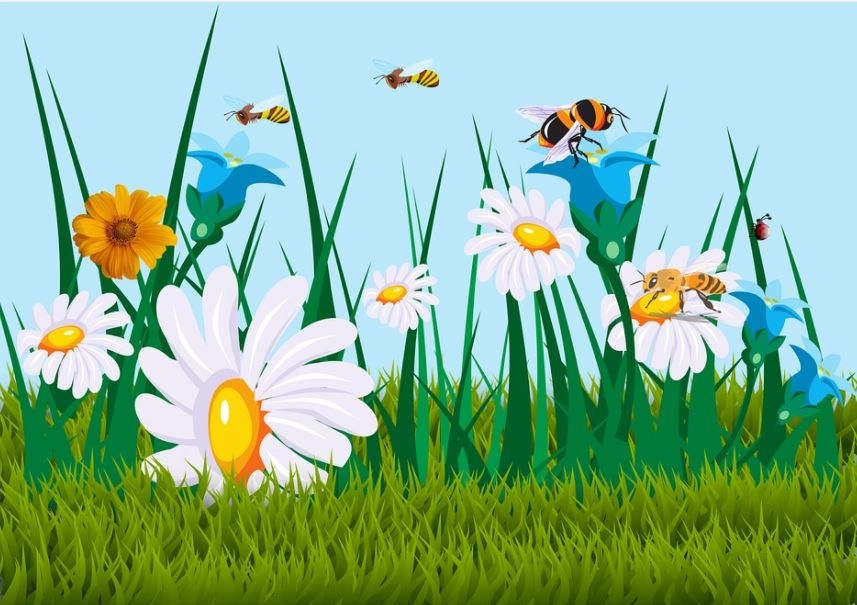
What is Pollination?
Pollination is the transfer of pollen grains from the stamen of a flower to the stigma of another plant. Pollen can be transmitted by birds, insects, wind, and humans, and it is a critical step in plant reproduction. Pollinated flowers produce fruits and seeds. Pollination between different species helps increase genetic diversity within a population, making it more robust against diseases and dangerous environmental conditions such as drought.
How do Pollinators Interact with Flowers?
For pollination to occur, two main things have to happen:
- A pollinator must come into contact with the anther cone of the stamen (which contains pollen), and
- The pollinator must come into contact with the stigma of the pistil.
Pollinators are attracted to flowers because they contain sugary nectar in the base of the flower or at the bottom of another cone left behind by other pollinators. Pollinators then drink this nectar before moving on to another flower. At some point, pollen will get stuck to their body, and when they visit another flower, it will be deposited onto the stigma of the pistil.
How Pollination Occurs?
For example, birds may eat fruits with seeds inside, helping plants grow when they excrete/defecate the seeds many miles away from where they initially ate them. Insects stick around longer than birds because they have a reward in nectar for their efforts, so they usually transfer more pollen. Pollination by wind is less common but can still happen. Pollen is always released in anther cone, but when the wind blows hard enough, it can dislodge some pollen and carry it to another plant. Pollination occurs when the stamen’s anther cone releases its pollen, making its way down into the pistil’s stigma, where fertilization may occur if a compatible pollinator is in the area.
What are Pollinated Flowers?
Pollinated flowers produce fruits and seeds. Pollinated flowers grow bigger because their stem tissue has been replaced with fruit/seeds, which take up water and become heavy. The flower also gets slightly smaller in size due to this weight. Pollination happens in flowers, so it has male and female organs (stamen and pistil). Pollinated flowers produce fruits and seeds, while unpollinated flowers produce petals, pollen, and nectar. Pollen grains have a tough outer layer but are soft inside, so they can easily stick to an animal’s hair or body when they visit a flower. Pollen comes from the stamen of a plant’s male organ, called a flower. Fertilization occurs in the pistil of a plant’s female organ, called a flower. Pollinating agents such as birds and flies transfer pollen from one flower to another, thus fertilizing plants.
What do Pollinated Flowers Need?
For pollination to occur, there must be flowers. Pollinators like birds and insects are attracted to brightly colored flowers with sweet nectar at their base, pollinating them by drinking the nectar. Pollinated flowers need help from other organisms to reproduce.
Types of Pollination
All plants reproduce through pollination, and we have three main types of Pollination: Self Pollination, Cross-Pollination, and Open Pollinated Pollination.
- Self Pollination: This occurs when pollen from one flower pollinates another flower within the same plant. This usually happens with plants that have both male and female reproductive organs in each flower. So there’s no need for cross-pollinating with other plants. Some examples include apples, oranges, and grapes. Pollen from the stamen is transferred to the pistil and fertilizes the flower, which bores a fruit.
- Cross-Pollination: This is the transfer of pollen from one plant to another and then to the pistil, becoming a fruit or flower. Pollen can be transferred by wind, bees, animals, and even humans. Pollen travels from the anther (male) to the stigma (female). This process results in fertilization and seeds that produce the next generation of plants. Pollination agents must transfer pollen grains to the stigma of another plant before it can fertilize a flower. Examples include corn, sunflowers, and blueberries.
- Open Pollinated Pollination: This is the pollination of plants with no restrictions on who or what they are allowed to reproduce with. So, plants pollinated by wind, bees, butterflies, or humans may be pollinated under this condition. Pollen must be transferred to the stigma of another plant before it can fertilize a flower. Open pollination doesn’t usually produce hybrids, but it does cause random genetic changes in plants resulting from mutations. Some examples include pumpkins and tomatoes.
Other types of Pollination
Cross-Pollination: This type of pollination occurs when two flowers from different plants pollinate each other, usually via insects such as bees who carry pollen from one plant to another while collecting nectar. It is the most common Pollination method and affects most plants humans eat, like vegetables and legumes.
Close Pollination: This occurs when two or more plants within the same species produce pollen at different times, pollinating other plants still growing pollen grains. For example, if a plant with one ripe strawberry has pollen on day 1, it could pollinate another strawberry flower that will produce fruit five days later. It can be problematic because if both strawberries are fertilized simultaneously, the resulting fruit will have long stems and tiny fruit, leading to lower yields or potentially no yield at all. The type of pollination used dramatically affects the produce that is harvested.
Agents of Pollination
Agents of Pollination are the various organisms that are specialized to assist in pollen transfer during sexual reproduction. Agents can be insects, birds, bats, etc., and they are mainly classified as either ‘syndromic’ or ‘proboscis’ according to their anatomy.
Agents of Pollination are responsible for transferring pollen from one plant to another (or one part to another) within different types of plants. Agents also carry out passive and active types of pollination where insects use certain body parts to collect pollen grains while others contribute through genetic material contained within their flowers.
1. Syndromic Agents:
Syndromic agents can be insects or animals with appendages used for nectar feeding. These agents come into contact with the pollen while gathering food. It causes them to become covered in pollen, which will lead to cross-pollination between plants of the same species when the animal lands on another plant flower.
2, Proboscis Agents:
Proboscis Agents are animals that feed using a long “tongue” (called a proboscis) that comes into contact with the pollen while feeding. Sometimes, these animals feed on nectar without collecting any pollen (known as ‘nectar robbers’), but other times they collect pollen to take to other plants for food or nesting material. Regardless, this will assist in plant fertilization
Classification of Pollination Agents Based on The Type of Forces Involved
There are many different agents of pollination, all working in synergy with one another for this transfer to happen. Agents of Pollination include animals such as insects, bats, birds, and even primates; wind; water; and even, in some cases, self-pollination. Agents of Pollination can be grouped into three categories:
- Abiotic factors that use physical forces;
Biotic factors that work with living organisms; and
Autotrophic factors that involve self-pollinating plants.
- Abiotic Factors using Physical Forces
– Wind: One agent of pollination that uses physical forces is wind. Wind-pollinated plants tend to be large, with lightweight seeds and low specific gravity for the seed to float on the breeze. This Pollination mechanism has been observed in grasses such as bamboos, maize, sugarcane, and conifers such as pine trees. The pollen is also dispersed over more extensive areas due to its weightlessness. In addition to this, there are many different types of structures explicitly designed by the plant intended to catch windborne pollen grains, which can then germinate on a female flower close by.
- Biotic Agents
– Insects: While not all insects play a role in pollination, many are responsible. Insects are involved in almost all types of plants regarding pollination, except for wind-pollinated plants. Biotic agents such as insects can play a role in pollination through various methods. The two main methods are active Pollination and passive Pollination; both carried out by different insect species within this category. For example:
– Bees and wasps carry out active pollination by collecting pollen from one flower and carrying it to another flower of the same species or different but similar species (such as tomatoes and basil). They usually do so intentionally while foraging for nectar and pollen. Bees use specialized structures on their legs called scope that collects grains which are then carried back to the hive. There it is used to feed the brood or stored as bee bread.
– Butterflies and moths play a role in pollinating flowers through passive pollination, where they are passively dusted with pollen while moving from one part of their life cycle to another. For example, butterflies use specialized structures called ‘proboscides’ which act like straws, sucking up fluids such as nectar and water. These fluid-filled snouts can be dipped into viscous substances such as pollen grains for further examination around other plants, thus spreading the pollen grains to different parts of its body. Once this has occurred, antibodies begin building up at certain points on their bodies which cause the allergens to be deposited on the stigma of surrounding flowers, allowing pollination to occur.
– Bats: In some cases, bats can play a role in active pollination by carrying pollen from one plant to another, but this is only the case for specific types of flowering plants, including bananas, peaches, and avocadoes. This seems to result from coevolution as these plants have developed very specialized structures that attract bat species specifically to facilitate their pollination process. These structures include large petals called ‘banana leaves,’ which function as landing pads for flying foxes (fruit bats) who rest and feed on nectar before moving on to another plant.
- Self-Pollinating Agents
Wind-pollinated plants are self-pollinating agents as the pollen spreads to other plants naturally without the help of animals or insects. The pollen grains are lightweight, meaning they can be carried over long distances by wind currents, sometimes up to hundreds of kilometers away from their origin plant. It ensures that cross-pollination does not occur but continues instead within clumps of plants within similar geographical regions.
- Autotrophic Agents
This type of agent has developed a way to self-pollinate using genetic material within the flower it inhabits. An example is corn that belongs to this category; it uses both male and female parts residing inside each flower on its cob for this purpose, allowing it to reproduce in a short space of time. Corn is one plant that has developed in such a way in response to the human population, which has helped it adapt, ensuring its survival.
Why are Pollination Agents so Important?
Agents of Pollination are essential for various reasons, including increasing genetic diversity within a population and out-crossing, which reduces the risk of inbreeding depression. Agents also help increase seed production through pollinating seeds that would not have developed otherwise due to isolation from other plants’ pollen or lack of pollinators during certain times of the year. Agents can even be indicators of conservation status because the loss of specific pollinators threatens some species. Agents are essential for agriculture because they increase crop yields, necessary for feeding our growing human population.
In summary of the above, Pollinators play a crucial role in maintaining the balance of our environment. They help preserve biodiversity, and without them, many plants would not be able to survive or reproduce effectively. Some species pollinated by animals such as birds and bats often need large areas of habitat free from human disturbance if they thrive and persist within an area. However, there is still much we don’t know about agents of pollination, which makes it hard for us to make informed conservation decisions. Pollination is an essential ecological process that links plants, animals, and the environment in various ways.
Pollination helps maintain biodiversity by allowing individuals within groups to mix their genes which are otherwise isolated from one another due to physical barriers or lack of pollinators during certain times of the year. Pollination also contributes to seed production by increasing genetic diversity among plant populations through cross-pollinating seeds with different alleles. The latter increases the survival rates for some species because they will not become threatened by inbreeding depression, so extinction becomes possible less likely.



